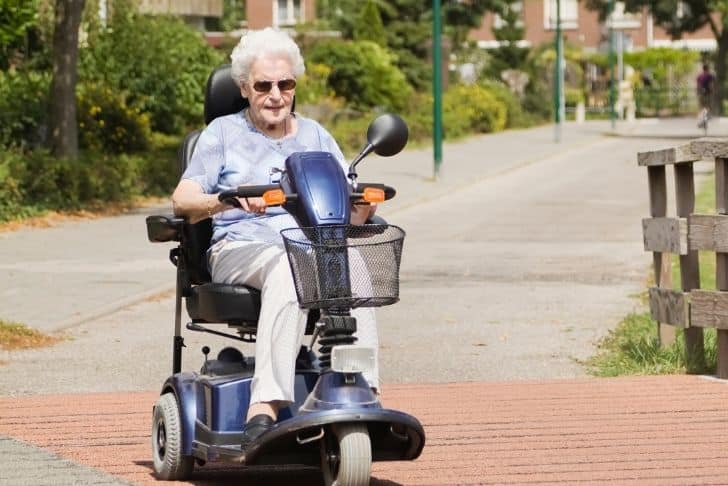Finding the perfect mobility aid that suits your individual needs can be a daunting task, but a physical examination by a healthcare professional can ease this journey substantially. They possess the specialized knowledge to guide you through a plethora of options, whether it’s canes designed for minimal balance impairments, walkers, or rollators that offer more support, or power scooters and manual and power wheelchairs tailored to those with major mobility impairments. Moreover, they can help navigate the often complex world of insurance. Power wheelchairs, for example, come in an array of makes, models, and sizes. However, they’re designed for those with more severe mobility impairments, so understanding this and perhaps other more nuanced details is where a doctor’s expertise comes in handy. Remember, even though mobility aids seem beneficial, using them before it’s necessary can deteriorate your overall mobility, activity levels, and health. Hence, it’s imperative to approach this process with careful consideration and expert advice.

Understanding the Role of Healthcare Professionals in Selecting Mobility Aids
Looking for mobility aids can be overwhelming with a wide array of options available in the market. This is why healthcare professionals, especially doctors and nurses, play a vital role in selecting the right fit for your needs and abilities.
Role of Doctors and Nurses
Medics are typically well versed in the strengths and weaknesses of different mobility aids. They can provide valuable advice based on your specific conditions, lifestyle, and needs. Doctors can diagnose your mobility issues, while nurses, especially those in rehabilitation care, can support you with their practical knowledge about mobility aids including how to use them properly for best results and safety.
The Necessity of a Professional Assessment
Getting a professional assessment is a critical part of the process of choosing mobility aids. A healthcare professional evaluates your mobility level, lifestyle, habitual activities, and living conditions. Their expert evaluation ensures that you get mobility aid that matches your need, which prevents potential unwanted complications or accidents.
Understanding Patients’ Unique Needs
Everyone has unique needs and requirements that must be considered when choosing mobility aids. This includes things like your body mass, strength, coordination, endurance, balance, ease of use and the environment where you’ll use the device. Healthcare professionals make sure that all these individual factors are taken into consideration to get you the aid which complements and supports you the best.
Exploring Different Types of Mobility Aids
There are several types of mobility aids customized to cater to varying degrees of mobility impairments. Knowing the specifics of each can help in making informed decisions.
Understanding Canes and Their Use
Canes are most useful for those with minimal balance impairments, or when one leg is significantly weaker than the other. This device takes some of your weight off your lower limbs, making it easier to walk.
Study on Walkers and Rollators
Walker, on the other hand, are typically used by individuals with greater mobility issues. They provide more balance and support than canes. Further, rollators, the wheeled versions of walkers, also have a built-in seat that can be used when rest is needed.
Discussions on Manual Wheelchairs
When there’s a need for more substantial support, manual wheelchairs come in to play. There are multiple types available including standard, lightweight, and ultra-lightweight designs, each designed to cater to different user needs.
Explaining Power Wheelchairs
Power wheelchairs are designed for individuals with severe mobility impairments. They are perfect for those who lack the upper body strength to operate manual wheelchairs.
Which Device is Suitable for Its Users?
The one-size-fits-all concept doesn’t apply here. One mobility aid might work perfectly for one individual but might not for others. It’s crucial for healthcare professionals to match the device accurately to the user’s specific need ensuring convenience, safety, and increased independence.
Assessing Patients with Minimal Balance Impairments: The Use of Canes
Individuals with minor balancing issues can enormously benefit from canes, thus understanding the physical examination to determine balance issues, advantages and limitations of canes; and different types of canes is crucial.
Physical Examination to Determine Balance Issues
During a physical exam, healthcare professionals assess your strength, balance, coordination, and the way you walk. This helps them decide if a cane is suitable for your needs. They may even provide you training on the correct way to use a cane for utmost benefits.
Advantages and Limitations of Canes
Canes are portable and lightweight, making them easy to use. They can improve your balance and take some weight off your lower limbs, but they’re not designed for people who need full weight-bearing assistance.
Different Types of Canes: Single Point and Quad Base
There are several types of canes available in the market. The traditional single point cane is excellent for light support. If you need more stability and balance, a quad base cane, equipped with four small feet at the base, could be a better choice.
Understanding the Necessity of Walkers and Rollators for Hand and Arm Strength
For people with moderate mobility issues, walkers and rollators can be a lifesaver. They provide more support and balance than canes. However, these require an adequate amount of hand and arm strength to operate.
Strength Assessment by Healthcare Professionals
Your healthcare provider will assess the strength of your arms and hands to determine if you can use a walker or rollator. If you lack in these areas, other options may be explored.
Benefits and Drawbacks of Walkers
Walkers provide excellent stability and are easy to operate. They can, however, be somewhat bulky and difficult to transport. Unlike rollators, walkers need to be lifted for movement which might be difficult for some users.
Understanding Rollators and their Usage
Rollators, also known as rolling walkers, come with built-in seats and brakes, making them an increasingly popular choice. They provide a higher level of support than standard walkers and are easier to operate but can be a bit pricier.

Overview of Power Scooters for Persistent Travelling
Power scooters are great for seniors who struggle to walk long distances but can sit upright and control the throttle for extended periods.
Sustained Traveling: Who Needs Power Scooters?
If you find it challenging to walk long distances, or you tire easily, a power scooter could be the right choice. It can make shopping, attending social events, and outdoor activities easier and more enjoyable.
Power Scooters: Benefits and Cautionary Notes
Power scooters provide a comfortable and efficient mode of transport. However, they require good hand-eye coordination and upper body strength to operate. It’s important to get proper training to ensure safety.
Physical Examination to Ensure Safe Use of Power Scooters
Before suggesting power scooter usage, healthcare professionals will conduct a comprehensive physical examination to ensure that you have the necessary strength and coordination to operate it safely.
Delving Deeper into Manual Wheelchairs
Manual wheelchairs are an essential device for individuals who need considerable support. Understanding the different types, their advantages, and limitations can assist in making the right choice.
The Need for Manual Wheelchairs: Comprehensive Examination
Your healthcare provider will conduct a thorough examination to determine whether a manual wheelchair is necessary. Factors like your strength, coordination, and mobility are taken into consideration.
Different Types of Manual Wheelchairs: Standard, Lightweight, Ultra-lightweight
There are several types of manual wheelchairs available on the market. Standard wheelchairs are highly durable but a bit heavy. Lightweight models are easier to push and transport, while ultra-lightweight wheelchairs are great for very active users who want the lightest weight possible.
Addressing the Pluses and Minuses of Manual Wheelchairs
Manual wheelchairs significantly ease mobility for users. However, they require upper body strength for operation and are sometimes difficult to maneuver over rough terrain or steep areas.

Highlight on Power Wheelchairs: For Severe Mobility Impairments
Power wheelchairs are advanced mobility aids that cater to individuals with severe mobility impairments.
Determining Severe Mobility Impairments: Physical Examination
To assess the requirement of power wheelchair, a comprehensive physical examination is performed. It evaluates your strength, mobility, and daily living activities, after which deciding on a power wheelchair becomes feasible.
How Different Power Wheelchairs cater to Varying Needs
Power wheelchairs are highly customizable. They vary in design and come with numerous options for seating, control systems, and other features to accommodate specific user needs.
Power Wheelchairs: Advantages and Points of Caution
While power wheelchairs offer advanced mobility aid and are handy for long-term use, they are also quite expensive. Furthermore, they require regular maintenance and their size can be problematic for quite some houses and buildings.
The Insurance Aspect of Acquiring Mobility Aids
Getting a mobility aid could be expensive and most people would prefer if insurance covered the cost.
Insurance Coverage for Durable Medical Equipment
Most insurance carriers cover mobility aids under the category of Durable Medical Equipment (DME), but different insurance companies have different coverage policies. It’s vital to confirm coverage prior to purchasing.
Dealing with Paperwork and Criteria
Acquiring mobility aid involves lots of paperwork. Medical necessity documentation from your doctor, authorization from the insurance provider and understanding the overall insurance policy criteria can all be part of the process. It’s advisable to gather all necessary information to avoid last-minute surprises.
Understanding Out of Pocket Expenses
While insurance may cover the cost of the equipment itself, extras and accessories typically come out of pocket. Before making any purchase, it’s essential to discuss and clarify these matters with the provider.
The Cruciality of Referrals and Physical Examination for Choosing Mobility Aids
Referrals and physical examination play critical roles in the selection of suitable mobility aids.
Delving into the Importance of Medical Referral
A professional medical referral is crucial when you’re looking for a mobility aid. It not only increases the chances of getting the right device but also of having insurance cover the cost.
Physical Examination: A Step-by-Step Process
During physical examinations, medical professionals evaluate things like your body strength, coordination, balance, and general mobility. These evaluations are used to determine the type of mobility aid best suited for an individual.
Finding the Perfect Match: Patients and Mobility Aids
The ultimate goal is to find a mobility aid that matches perfectly with your needs and lifestyle. This improves safety, comfort, and independence, particularly for seniors.
Assessing the Negative Impact of Premature Use of Mobility Aids
Using mobility aids before they’re needed can have negative effects on a senior’s health and activity levels.
Understanding the Downsides of Early Use
Premature use of mobility aids can lead to muscle weakness, decreased balance, and even increase the risk of falls. It might also promote dependence, reducing the motivation to maintain or improve mobility.
How Early Use Affects Mobility and Activity Levels
Using a mobility aid too early can lead to decreased physical activity and result in additional mobility loss. Therefore, it’s imperative to use these aids as per professional advice.
Why Expert Advice and Careful Consideration is Vital
Mobility aids should only be used when medically advised. They are not to be used for convenience or as preventive measures. It’s always best to rely on expert advice and careful consideration when deciding on using mobility aids.
